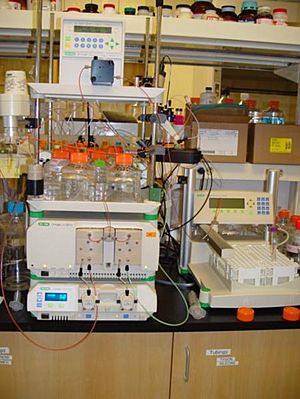Size-exclusion chromatography facts for kids

Equipment for running size-exclusion chromatography. The buffer is pumped through the column (right) by a computer-controlled device
|
|
| Acronym | SEC |
|---|---|
| Classification | Chromatography |
| Analytes | macromolecules synthetic polymers biomolecules |
| Manufacturers | GE, Bio-Rad, Knauer, emp Biotech |
| Other techniques | |
| Related | High-performance liquid chromatography Aqueous normal-phase chromatography Ion exchange chromatography Micellar liquid chromatography |
Size-Exclusion Chromatography (SEC) is a cool way to separate different parts of a mixture. Imagine you have a mix of tiny and big things. SEC helps you sort them out based on their size. It's like a special filter that lets the big stuff out first, and the small stuff takes longer to get through.
This method is super useful for separating large molecules, like the ones found in living things (biomolecules) or man-made plastics (polymers).
Contents
How Does SEC Work?
A special tube called a "column" is at the heart of SEC. Inside this column, there are two main parts:
- Mobile phase: This is a liquid, like water, that carries your mixture through the column. It's always moving!
- Stationary phase: This part doesn't move. It's usually made of tiny beads with lots of tiny holes, like a sponge.
Unlike some other separation methods, SEC doesn't care if a molecule is "sticky" or "slippery." It only cares about size. There's no chemical reaction between the molecules and the beads.
What are the Beads Made Of?
The tiny beads in the column can be made from different materials:
- Porous solids: Often made of silica, which is like a very strong, tiny glass. These beads have small holes (pores) that are super stable. But sometimes, they can accidentally break down or absorb the molecules you're trying to separate.
- Porous gels: These are more like squishy, sponge-like materials made of long chains of molecules (polymers). Gels are often better at letting molecules pass through their pores, and they come with a wider range of pore sizes.
So, how do big molecules get out first? Think of it like a maze:
- Big molecules: They are too large to fit into most of the tiny holes in the beads. So, they have to travel around the beads, taking a shorter, more direct path through the column. They exit the column quickly.
- Small molecules: These tiny molecules can easily fit into the holes in the beads. They get "stuck" for a bit, exploring all the nooks and crannies. This makes their path much longer, so they take more time to travel through the column and exit last.
The smaller a molecule is, the more likely it is to get into the pores, and the longer it stays inside the column.
Understanding a Chromatogram
After you run an SEC experiment, you get a graph called a "chromatogram." This graph shows you what came out of the column and when.
- The graph usually plots "retention time" (how long a molecule stayed in the column) against "molecular weight" (how heavy a molecule is).
- You'll see "peaks" on the graph. Each peak tells you about the amount of molecules of a certain size that came out.
- Exclusion limit: This is the largest size of molecule that can fit into any pore. Molecules bigger than this limit will always come out first.
- Permeation limit: This is the smallest size of molecule that can fit into a pore. Molecules smaller than this limit will get into almost all pores and come out last.
- The area between these two limits is called the permeation region. This is where most of the separation happens, showing you the range of molecule sizes in your sample.
Pros and Cons of SEC
Like any tool, SEC has its good points and not-so-good points.
Advantages of SEC
- Speed control: You can often adjust how fast or slow the separation process is, depending on what you're trying to separate.
- Clear results: The peaks on the chromatogram are usually very clear and sharp. This means SEC can give you good, precise information.
- Low sample loss: In theory, your sample molecules don't stick to the beads, so you don't lose much of your sample during the process.
- Good separation: The stable beads can be packed tightly, which helps to separate the different parts of your mixture very well.
Disadvantages of SEC
- Overlapping peaks: If you try to make the process too fast, the peaks on your graph might overlap. This makes it hard to tell different molecules apart.
- Similar sizes: SEC struggles to tell the difference between molecules that are very close in size. For example, if two molecules are almost the same weight, SEC might show them as one peak, even if they are different. To see them as separate peaks, their sizes usually need to be at least 10% different.
- No distinction for isomers: SEC can't tell the difference between molecules like enantiomers or diastereomers. These are molecules that have the same weight but slightly different shapes.
- Doesn't consider stickiness: SEC doesn't account for how "sticky" or "thick" a molecule is (its viscosity). It only focuses on size.
Images for kids



